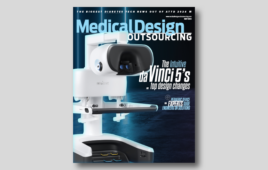
[Screenshot obtained from Pitt video demonstration]
This neurotechnology instantly improves arm and hand mobility in those affected by stroke. It could allow those affected by moderate to severe stroke to conduct normal daily activities more easily.
The researchers published their report in Nature Medicine.
According to a news story on the Pitt website, the researchers implanted a pair of thin, metal electrodes resembling strands of spaghetti along the neck. These electrodes engage intact neural circuits, allowing stroke patients to fully open and close their fist. Patients also may lift their arm above their head or use a fork and knife to cut a piece of steak.
“We discovered that electrical stimulation of specific spinal cord regions enables patients to move their arm in ways that they are not able to do without the stimulation. Perhaps even more interesting, we found that after a few weeks of use, some of these improvements endure when the stimulation is switched off, indicating exciting avenues for the future of stroke therapies,” said corresponding and co-senior author Marco Capogrosso, assistant professor of neurological surgery at Pitt. “Thanks to years of preclinical research building up to this point, we have developed a practical, easy-to-use stimulation protocol adapting existing FDA-approved clinical technologies that could be easily translated to the hospital and quickly moved from the lab to the clinic.”
Creating an effective treatment for paralysis from stroke
The researchers cite data demonstrating that one in four adults over 25 years old will suffer a stroke in their lifetime. Of that population, 75% will have lasting deficits in motor control of their arm and hand.
Spinal cord stimulation uses the electrodes to deliver pulses of electricity that activate nerve cells inside the spinal cord. Such technology already successfully treats high-grade, persistent pain. Other research groups showed that it can restore movement to the legs after spinal cord injury, the Pitt team said.
However, challenges arise in the complexity of the neural signals controlling the arm and hand. Another factor comes in the form of the unique dexterity of the human hand and the wide range of motion provided by the shoulder.
“Creating effective neurorehabilitation solutions for people affected by movement impairment after stroke is becoming ever more urgent,” said senior co-author Elvira Pirondini, assistant professor of physical medicine and rehabilitation at Pitt. “Even mild deficits resulting from a stroke can isolate people from social and professional lives and become very debilitating, with motor impairments in the arm and hand being especially taxing and impeding simple daily activities, such as writing, eating and getting dressed.”
The researchers bring their tech to humans
First, the team conducted preclinical studies with computer modeling and animal testing in macaque monkeys with partial arm paralysis. Soon, they garnered clearance to test the therapy in humans.
In a series of tests adapted to individual patients, stimulation enabled patients to perform tasks of different complexities. These included moving a hollow metal cylinder and grasping common household objects, as well as opening a lock. Clinical assessments demonstrated improved strength, range of movement and function of the arm and hand.
Additionally, the scientists observed that the effects seemed longer-lasting than originally thought. Such effects even persisted after device removal. The team said this suggests they could use the device as an assistive and restorative method for upper limb recovery. This method could even enable intense physical training, leading stronger long-term improvements in the absence of stimulation, they said.
Future plans for the spinal cord stimulation tech
The team plans to enroll additional trial participants. They seek to understand which stroke patients can benefit most from the therapy and to optimize protocols for different severities. Pitt and Carnegie Mellon-founded startup Reach Neuro also aims to translate the therapy into clinical use.
“The sensory nerves from the arm and hand send signals to motor neurons in the spinal cord that control the muscles of the limb,” said co-senior author Douglas Weber, professor of mechanical engineering at the Neuroscience Institute at Carnegie Mellon University. “By stimulating these sensory nerves, we can amplify the activity of muscles that have been weakened by stroke. Importantly, the patient retains full control of their movements: The stimulation is assistive and strengthens muscle activation only when patients are trying to move.”
Stimulation technology with mobility rehabilitation at its core already exists on the U.S. market. In May 2022, MicroTransponder announced the first commercial implantation of its Vivistim paired VNS system for chronic ischemic stroke rehabilitation.




![A photo of the Medtronic GI Genius ColonPro polyp detection system flagging a potential sign of colon cancer during a colonoscopy. [Photo courtesy of Medtronic]](https://www.medicaldesignandoutsourcing.com/wp-content/uploads/2024/04/Medtronic-GI-Genius-doctors-268x170.jpg)